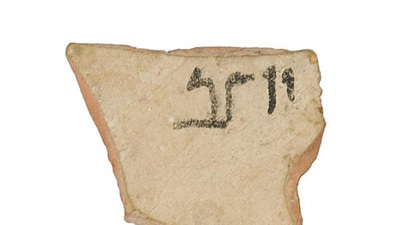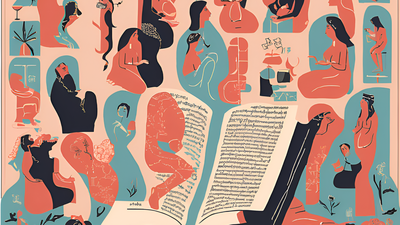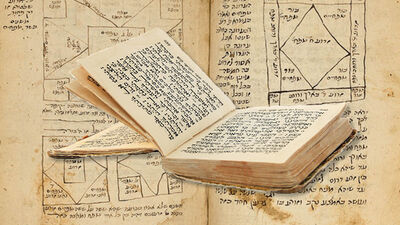One of the most mysterious components of human existence is why males and females are physically attracted to each other. What is there in their physical appearance that makes them so excited that they want to be intimate, to the point where they consider this the greatest form of joy?
After all, if we could ask an alien from another planet whether they find us physically attractive, we would probably get a most unfavorable answer. In the eyes of such a being, the human body consists of the most repulsive components: a fleshy corpse with a skull on top (made even more hideous by the hole in the middle into which we drop our food) and with two deformed pieces of flesh on the side so that we can hear, and two pieces of bendable glass through which we see.
The same is true of the rest of the body. Strange pieces of flesh and bones hang on the two sides of the corpse which can turn in nearly every direction, with five digits at the end with which we perform all kinds of strange actions, such blowing our noses (of which the less said, the better!).
Lower down things get even worse – too ghastly even to describe! Strange organs with which you can manufacture more similar ugly creatures.
So why would anyone ever dare to get closer to each other? One look in the mirror and you will understand these extraterrestrial beings’ point of view!
We must conclude that the attraction of men and women is in no way rational or self-explanatory. Rather, it is imposed by the mind. Something in our minds convinces us that the human body is the summit of beauty and charm.
Sexual attraction is – like anything else – a mystery. If the brain did not provide us with a special region to create these feelings, no one would have any interest in sex. In fact, we would consider it repulsive.
The sages of Israel understood the enormous power of sex and its immense challenges. Unlike other religions, such as classical Christianity, they never saw sexuality in a negative way. They praised it as a divine gift and instructed people to take pleasure in it, as long as it was kept within the bounds set by the laws of Torah. These laws include observances such as the monthly abstention from sex while a woman is menstruating, until she immerses in a mikvah (ritual bath) at the end of this period.
Not once did the sages deny the beauty of sex, nor its joy. They saw it as something holy, not to be desecrated. However, they themselves experienced how quickly the sexual drive could overtake a man and bring him to evil. Several times the Talmud tells us that even the greatest among them (nearly) violated its holiness. (1)
Most remarkable and revealing is the story about the great Sage Abbaye (third century), one of the outstanding teachers in the Talmudic period. He realized that he would not have been able to overcome his sexual impulse, if he spent a long time alone with a woman. He felt greatly embarrassed by this until an old sage came by (to whom Abbaye must have told the reason for his mental anguish) and taught him: The greater the man, the stronger his sexual drive (libido). (Succot, 52a)
This a revealing observation: there is a direct relationship between spirituality and sexuality. The more holiness, the greater the sexual impulse.
Why is this? And what does it mean?
In a remarkable and daring observation stated in the name of the Baal Shem Tov, the father of Chassidut, we read: “From my own flesh, I behold God”, (Iyov 19:26).” “Just as no child can be born as a result of physical copulation, unless this is performed with a vitalized organ and with joy and desire, so is it with spiritual copulation, that is the study of the Torah and prayer. When it is performed with a vitalized organ, (the brain) and with joy and delight, then does it give birth (to a greater prayer and Torah study) (Keter Shem tov, reprinted in Jerusalem, 1968).”
And on another occasion, the Chassidic masters couched it even more in direct terms: “Prayer is copulation with the Shechina (God’s indwelling). Just as there is swaying when copulation begins, so too, a man must sway at first (“shockling” in Yiddish), and then he can remain immobile and attach to the Shechina with great attachment. As a result of his swaying, man is able to attain a powerful stage of arousal. For he will ask himself: “Why do I sway my body? Presumably it is because the Shechina stands over against me.” (And I cannot contain myself.) And as a result he will attain a level of great enthusiasm.” (Tzava’at Ha-Ribash, Jerusalem, p.7b; Likutei Yekarim, Lemberg, 1865, p. 1b; Sefer Baal Shem Tov, Satmar, 1943, vol. 1, p. 145, note 65). (2)
Prayer is compared to the sexual act. Both require intensive joy, to the extent that the sexual act is seen as a prayer with one’s body. The concept that one should serve God with simcha (joy) means that real prayer can only take place with as great a joy as that found in the sexual act.
This is what the old sage taught Abbaye: The greater the man, the stronger his sexual drive.
It is as if Judaism is saying that the ultimate religious experience must have the same quality as the sexual act.
The intense joy of the sexual act is a heavenly experience. This is the reason why there is such enormous respect for the human body in Judaism. There is no denial of the physical body, but rather the reverse – an affirmation of the pleasure which the body provides man.
God planted this pleasure principle in man, so that he should enjoy it and also come closer to God.
But this is not all. There is a concept in Chassidic literature called “the elevation of strange thoughts.” This means that one should not attempt to push inappropriate thoughts out of one’s mind, but elevate them. Elevation in this context means to trace them to their source in God, since from Him come all things, and thus deprive them of their baneful power. For example, suppose that a man suddenly finds that his devotions are being distracted by thoughts about a beautiful woman to whom he is not married. If he begins to dwell on the fact that her beauty is only a pale reflection of the source of all beauty in comparison with the divine, he will be able to re-direct his unwanted thoughts, and turn them into holiness. In that way he has managed to cope with this distraction, not by rejecting it, but by redeeming it for a higher purpose.
The implication is that the very sexual desire – even for someone who is forbidden to us – is in fact holy, since these very feelings are a creation and gift of God. It is not the feelings themselves that are wrong, but the fact that they arise in connection to something forbidden to us.
The great Chassidic master, Rabbi Yacov Joseph of Pulnoye (18th century) states “that he heard in the name of his master the Baal Shem Tov how to straighten out strange thoughts. If it is thoughts of women, he should intend to elevate them by attaching them to the root of Chesed (loving kindness) according to the mystery of “And if a man shall take his sister, (…) it is Chesed, kindliness (normally translated with a “disgrace”,) (…) he shall bear his iniquity” (Vayikra 20, 17). (3)
In other words what we normally see as a disgrace is in fact a kindness, since the feelings in themselves are holy, and only the application of them to his sister is a disgrace and absolutely forbidden.
Even illicit love stems ultimately from Chesed (divine kindness), but it must be rejected because its object is forbidden. But the fact that people have these feelings is because they come from God, who created them.
Certainly, this idea has been the topic of much discussion and controversy, and some rabbis have strongly objected to this viewpoint. (4)
Still it cannot be denied that this idea provides a response to the question of why are men and women are attracted to each other? The answer is that it is completely mysterious and imposed by the mind. And as such it is divine.
(1) See for example Kiddushin 81a and 81b.
(2) See Louis Jacobs, Hassidic Prayer, Schocken Books, NY, 1973, page 60.
(3) Toledot Yacov, Joseph, page 75b.
(4) See for example, Rabbi David of Makof, (19th century), Shever Posheim, See, M. Wilensky, Hasidim u Mitnagdim, Jerusalem, 1970,vol 1, p.159, as quoted by Louis Jacobs, ibid, pp, 112-11.






